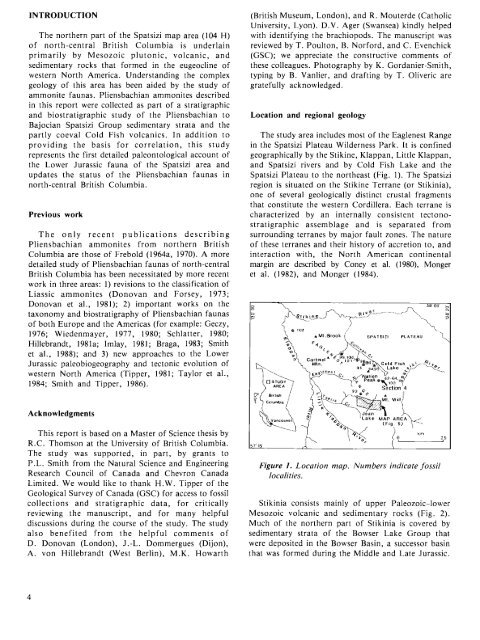PLIENSBACHIAN (LOWER JURASSIC) BIOSTRATIGRAPHY AND ...
PLIENSBACHIAN (LOWER JURASSIC) BIOSTRATIGRAPHY AND ...
PLIENSBACHIAN (LOWER JURASSIC) BIOSTRATIGRAPHY AND ...
You also want an ePaper? Increase the reach of your titles
YUMPU automatically turns print PDFs into web optimized ePapers that Google loves.
INTRODUCTION<br />
The northern part of the Spatsizi map area (104 H)<br />
of north-central British Columbia is underlain<br />
prim arily by Mesozoic plutonic, volcanic, and<br />
sedimentary rocks that formed in the eugeocline of<br />
western North America. Understanding the complex<br />
geology of this area has been aided by the study of<br />
ammonite faunas. Pliensbachian ammonites described<br />
in this report were collected as part of a stratigraphic<br />
and biostratigraphic study of the Pliensbachian to<br />
Bajocian Spatsizi Group sedimentary strata and the<br />
partly coeval Cold Fish volcanics. In addition to<br />
providing the basis for correlation, this study<br />
represents the first detailed paleontological account of<br />
the Lower Jurassic fauna of the Spatsizi area and<br />
updates the status of the Pliensbachian faunas in<br />
north-central British Columbia.<br />
Previous work<br />
T he only recent p u b lic a tio n s d escrib in g<br />
Pliensbachian ammonites from northern British<br />
Columbia are those of Frebold (1964a, 1970). A more<br />
detailed study of Pliensbachian faunas of north-central<br />
British Columbia has been necessitated by more recent<br />
work in three areas: 1) revisions to the classification of<br />
Liassic ammonites (Donovan and Forsey, 1973;<br />
Donovan et al., 1981); 2) important works on the<br />
taxonomy and biostratigraphy of Pliensbachian faunas<br />
of both Europe and the Americas (for example: Geczy,<br />
1976; Wiedenmayer, 1977, 1980; Schlatter, 1980;<br />
Hillebrandt, 1981a; Imlay, 1981; Braga, 1983; Smith<br />
et al., 1988); and 3) new approaches to the Lower<br />
Jurassic paleobiogeography and tectonic evolution of<br />
western North America (Tipper, 1981; Taylor et al.,<br />
1984; Smith and Tipper, 1986).<br />
Acknowledgments<br />
This report is based on a Master of Science thesis by<br />
R.C. Thomson at the University of British Columbia.<br />
The study was supported, in part, by grants to<br />
P.L. Smith from the Natural Science and Engineering<br />
Research Council of Canada and Chevron Canada<br />
Limited. We would like to thank H.W. Tipper of the<br />
Geological Survey of Canada (GSC) for access to fossil<br />
collections and stratigraphic data, for critically<br />
reviewing the manuscript, and for many helpful<br />
discussions during the course of the study. The study<br />
also benefited from the helpful comments of<br />
D. Donovan (London), J.-L. Dommergues (Dijon),<br />
A. von Hillebrandt (West Berlin), M.K. Howarth<br />
(British Museum, London), and R. Mouterde (Catholic<br />
University, Lyon). D.V. Ager (Swansea) kindly helped<br />
with identifying the brachiopods. The manuscript was<br />
reviewed by T. Poulton, B. Norford, and C. Evenchick<br />
(GSC); we appreciate the constructive comments of<br />
these colleagues. Photography by K. Gordanier-Smith,<br />
typing by B. Vanlier, and drafting by T. Oliveric are<br />
gratefully acknowledged.<br />
Location and regional geology<br />
The study area includes most of the Eaglenest Range<br />
in the Spatsizi Plateau Wilderness Park. It is confined<br />
geographically by the Stikine, Klappan, Little Klappan,<br />
and Spatsizi rivers and by Cold Fish Lake and the<br />
Spatsizi Plateau to the northeast (Fig. 1). The Spatsizi<br />
region is situated on the Stikine Terrane (or Stikinia),<br />
one of several geologically distinct crustal fragments<br />
that constitute the western Cordillera. Each terrane is<br />
characterized by an internally consistent tectono-<br />
stratigraphic assemblage and is separated from<br />
surrounding terranes by major fault zones. The nature<br />
of these terranes and their history of accretion to, and<br />
interaction with, the North American continental<br />
margin are described by Coney et al. (1980), Monger<br />
et al. (1982), and Monger (1984).<br />
Figure 1. Location map. N um bers indicate fo ssil<br />
localities.<br />
Stikinia consists mainly of upper Paleozoic-lower<br />
Mesozoic volcanic and sedimentary rocks (Fig. 2).<br />
Much of the northern part of Stikinia is covered by<br />
sedimentary strata of the Bowser Lake Group that<br />
were deposited in the Bowser Basin, a successor basin<br />
that was formed during the Middle and Late Jurassic.

















